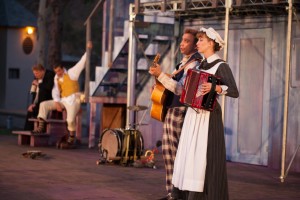The Point of Independent Shakespeare Company
The Bard, the park, and hard times
By Steven Leigh Morris

The evening I attended Independent Shakespeare Company’s free – I’ll say that again, free – production of Twelfth Night under the stars at Griffith Park, 500 people had gathered to see the company prance and mince and dance and sing and spit out their traditional, capable, jocular rendition of Shakespeare’s cruel comedy. The night before, 1400 souls had shown up for the same. I could go on about the many virtues of, and my quibbles with, Melissa Chalsma’s staging, but that’s all so small and beside the point — which is the larger question, what’s the point?
At first glance, there’s nothing “revolutionary” about free Shakespeare in the park. It’s just the kind of romp that’s been going on for years. On second glance, there is something decidedly revolutionary about it. Chalsma has cast actors of varying ethnicities in her production – nothing revolutionary about that either. More significant is the audience – one of the rare times in LA theater that the viewers reflect the population range of the city: from children to the aged, black, Latino, Pacific Rim, white.
At an unexpected moment in the show, Danny Campbell’s rotund Sir Toby Belch farts, then immediately curses the herring snack that caused his flatulence.
A 10-year-old boy a few yards away from me couldn’t contain himself, hyperventilating with laughter. It took his mother five minutes to calm him down. The young couple next to me, manicured and preened, and looking like they’d been helicoptered in from their Bel Air estate, introduced themselves and offered me a cup of the wine they’d brought. They didn’t “need” anything from me. I was a stranger to them. The gesture was simply, simple kindness.
It’s said in New York, the subway is where people of all income brackets and races bump into each other. Our subway/light rail is far more sequestered. I took the Blue Line last week all the way to downtown LA from Long Beach, a caravan of the impoverished. So where do we Angelenos tumble into that “rainbow” that our civic leaders keep crowing about? At the shopping mall? Maybe in the food court – a little. That’s depressing. Disneyland? Universal CityWalk? Oh, please. Maybe the beach, sort of.
The place to bump into the rest of the city, in the best sense, is Griffith Park in general, and at one of ISC’s productions in particular. The plays they put on use song and mirth and the illusion of heartache to remind us who we are, but perhaps less so than the space itself, the occasion, unencumbered by pretense and privilege and hierarchy and the balances on your credit cards. So long as you don’t defecate on the sidewalk or shoot the squirrels, you’re a welcome guest. And it’s free, for crap’s sake! Even the parking is free.
Which brings us to the larger point. As ISC’s co-founder David Melville says at every performance, hat in hand, pleading for contributions: “It’s not free for us to put on these plays.”
Certainly not. ISC’s administrative directors are on salary, the troupe pays its actors union wages, it also pays its designers. In 2012, the company reported revenues for the prior year of $424,000 – about 50% of which came from contributions, gifts and grants, the other 50% from “program service revenue,” which could be anything from master-classes to school programs. If ISC, which accurately defines itself as a charitable organization, has sustained the ratio of revenue-income to expenses that they reported in 2012 (which Office Administrator Sarah Cronk says they have), Melville’s appeal to the crowd, that the company is scraping by, has a ring of truth. According to their declaration, revenue barely exceeded expenses.
How can a company that offers such riches – to artists and audiences – year after year since 1998, be so poor? Welcome to the arts in America in the 21st century, and the larger question, what’s the point? I’m not talking about that 10-year-old boy’s laughter, which is, of course the point, or a point. The point is that this theater company, among the most successful as a business as any of its kind in the region, a theater company that provides such obvious value, should get so little value in return – not the value of validation and gratitude, but the other kind, the kind that exists in the land where people need to pay for leases and mortgages and college tuition and taxes and insurances and gasoline and utilities and food.
If ISC can’t pull off that hat trick, who can?
Which leads to the even larger point, highlighted in Thomas Piketty’s best-seller and now controversial book on modern economics, Capital in the 21st Century.
Using U.S. tax returns, Piketty (a professor at the Paris School of Economics) crunches the numbers to discover, big surprise!, that the wealth of the richest 1% of Americans increased 275%, between 1977 and 2007, while the next 60% saw an increase of under 40% over the same time period – and that study ended seven years ago. There’s no indication that this growing disparity of wealth has abated since then. Writes Piketty: “60% of the increase in US national income in the 30 years after 1977 went to just the top 1% of earners. The only section of the US population that has done better than the top 1% is the top 10th of that 1%. The top 100th of the 1% have done best of all.”
So what’s the problem? Let the rich get richer, the argument goes. What’s that got to do with the rest of us? What’s that got to do with the theater? Wealth will trickle down, say the Reagan-era economists. The greater the wealth, the larger the trickle. Let the market do its thing. Some of those in the top 1% will build hospitals, others will build football stadiums, others, such as Wallis Annenberg, will build a theater.
But the likes of the invaluable Annenberg don’t mitigate the growing impoverishment of the middle-class, and the many, multi-faceted costs of that impoverishment to the arts, from the people who can less afford to study and create art, to the people who can less afford to attend it, to the people who are so irretrievably exhausted from working three part-time jobs, going out to see Shakespeare in the park doesn’t even rate as an option.

Accordingly, says Piketty, our nation’s wealth has been trickling up, not down, and will continue to do so, to the detriment of our own fiscal security and political stability. Even if, according to his critics, Piketty doesn’t provide evidence that the nation’s wealth has been “stolen” from the middle-class and the poor, as he implies, an April 23, 2014 article in the New York Times, comparing American economic patterns to our European counterparts, supports that implication.
The article reports how, in 1980, Americans in all income brackets were wealthier than their counterparts anywhere in the world. Not so 30 years later. In 2010, according to the Luxemburg Income Study, our middle-class and poor had fallen behind the middle-class and poor populations in both Canada and Great Britain. Meanwhile, our upper-class remained (and remains) wealthier than their European counterparts.
According to the New York Times, a trifecta of causes accounts for this growing disparity: Education attainment has slipped in the U.S., leading to the failure of our youth to sustain the literacy, numeracy and the technological skills of even our own, older population, let alone our overseas counterparts and competitors.
“According to a recent study by the Organization for Economic Cooperation and Development, an international group . . . younger Americans are not keeping pace: Those between 16 and 24 rank near the bottom among rich countries, well behind their counterparts in Canada, Australia, Japan and Scandinavia and close to those in Italy and Spain.”
Then there’s the issue of salaries: “Pay in Canada has risen faster than pay in the United States and is now most likely higher. Pay in several European countries has also risen faster since 2010 than it has in the United States.”
And, finally, the most offensive culprit:
“Companies in the United States economy distribute a smaller share of their bounty to the middle-class and poor than similar companies elsewhere. Top executives make substantially more money in the United States than in other wealthy countries. The minimum wage is lower. Labor unions are weaker. And because the total bounty produced by the American economy has not been growing substantially faster here in recent decades than in Canada or Western Europe, most American workers are left receiving meager raises.”
I found data from the U.S. Census Bureau, showing how between 1967 and 2012, average American incomes (all races combined) rose from between 5% and 110% (as measured in 2012 US Dollars) depending on the age bracket. (The one exception was 15-24 year-olds, who saw a 10% decline, the only group to fall behind their 1967 counterparts.) However, in the 15-or-so years since the peak salary era of 1999 and 2000, every age bracket has lost from 7 to 17% of its average annual income. And if you look at the differentials in food, energy and housing costs between 2000 and 2014, you get a much clearer picture of how the middle-class and the poor are being financially squeezed.
But the most astonishing fact comes from a June, 2012 Salon article (“We’ve Been Brainwashed,” adapted from his book The Price of Inequality) by Columbia University economist Joseph Stiglitz, who says that only 42% of Americans actually believe that inequality has increased over the past 10 years, “when in fact the increase has been tectonic.”
Which brings us to what Stiglitz calls the malleability of beliefs, and back to ISC’s Twelfth Night in Griffith Park. There’s Malvolio, in a lovely performance by Luis Galindo, the prissy, pompous steward for his mistress, the Countess Olivia (Claudia de Vasco). Malvolio parades across the stage, gross-gartered in yellow stockings, grinning like an idiot – everything his mistress loathes – because he believed a forged letter, which he wrongly presumed was written by Olivia, urging him to dress and behave like the fool he now is. He’s been duped, but so ready to be duped, so eager to please his mistress, who gives him little more regard than she would a fly.
And for his ill-placed, almost snotty devotion to one above him in station, Malvolio winds up blindfolded in a dungeon, tormented by pranksters.
And though neither Shakespeare nor Chalsma’s interpretation of Twelfth Night make any allusions to the shifting lines of contemporary class divides, those divides are there for the taking.
In his Stage Raw essay last week, Guy Zimmerman closed with a statement that our friend, Colin Mitchell, at Bitter Lemons, found “as close to ridiculous as you can get.” (At least it wasn’t completely ridiculous.)
Wrote Zimmerman: “The larger question is whether the fate of theater in Los Angeles can be linked to larger trends in American culture, such as the concentration of wealth and power among the top one per cent. In my lifetime I’ve watched this segment of the population methodically decimate the American middle-class – and speaking selfishly I’d prefer to preserve my ability to shine a light from the stage on what they are doing.”
Countered Mitchell: “I have many disagreements with this assessment from Zimmerman – not the least being that somehow the health or lack thereof of small theater in LA is somehow a part of some conspiracy from the top 1% wage earners in this country to keep the truth tellers quiet (egads!)”
I couldn’t find the reference by Zimmerman to silencing truth tellers, probably because he didn’t write it. But over the past year or so, Open Fist Theatre has been priced out of its long-established home (for the second time!) in Hollywood; Celebration Theatre has been sent packing for the same reasons, also from Hollywood; while Rogue Machine (mid-City) and The Antaeus Company (North Hollywood) are biting their nails over rising rents in their respective areas. You’d have to be Malvolio not to recognize the connection between our most recent housing bubble (i.e. the accumulation of wealth) and its impact on local theater. And these are our top-drawer companies, two of them now silenced — or, at least, homeless.
However, Joseph Stiglitz and Paul Krugman, both Nobel Prize-winning economists, are surely more qualified than Zimmerman, Mitchell, or me to speak on the efficacy of the collusion that has led to the accumulation of wealth in this country, and the way the conversation about this collusion has been controlled, so I’ll just turn it over to Stiglitz:
“The fact that the 1 percent has so successfully shaped public perception testifies to the malleability of beliefs. When others engage in it, we call it ‘brainwashing’ and ‘propaganda.’ We look askance at these attempts to shape public views, because they are often seen as unbalanced and manipulative, without realizing that there is something akin going on in democracies, too.”
Stiglitz refers to shifts of wealth that have been “tectonic.” To be more Shakespearean, these are economic tempests, and ISC offers an amazing model for how to sail through them. The company’s productions are fully professional, salaried, popular, even commercial, and yet there’s no charge to see them. It that regard, ISC’s model spits in the face of the market forces that Zimmerman finds so polarizing. Their productions aren’t commodities to be purchased, they’re services to be rendered. If it’s true that their revenue has been slightly surpassing their expenses, they’re doing better than many of the larger theaters in town that charge $70 to $100 a ticket for shows with often only one to three actors.
I do believe that if theater can’t address and redress the conditions that ennoble and diminish us, it has no reason to be. ISC accomplishes this, not only in the content of its productions (it is Shakespeare, after all) but also in the financial model they’ve carved to bring live performances of the Bard to anybody with sufficient curiosity, and the wherewithal to get to Griffith Park. In a culture where the value of an enterprise is defined by the profit it can generate, ISC’s model is more than revolutionary, it’s miraculous.



